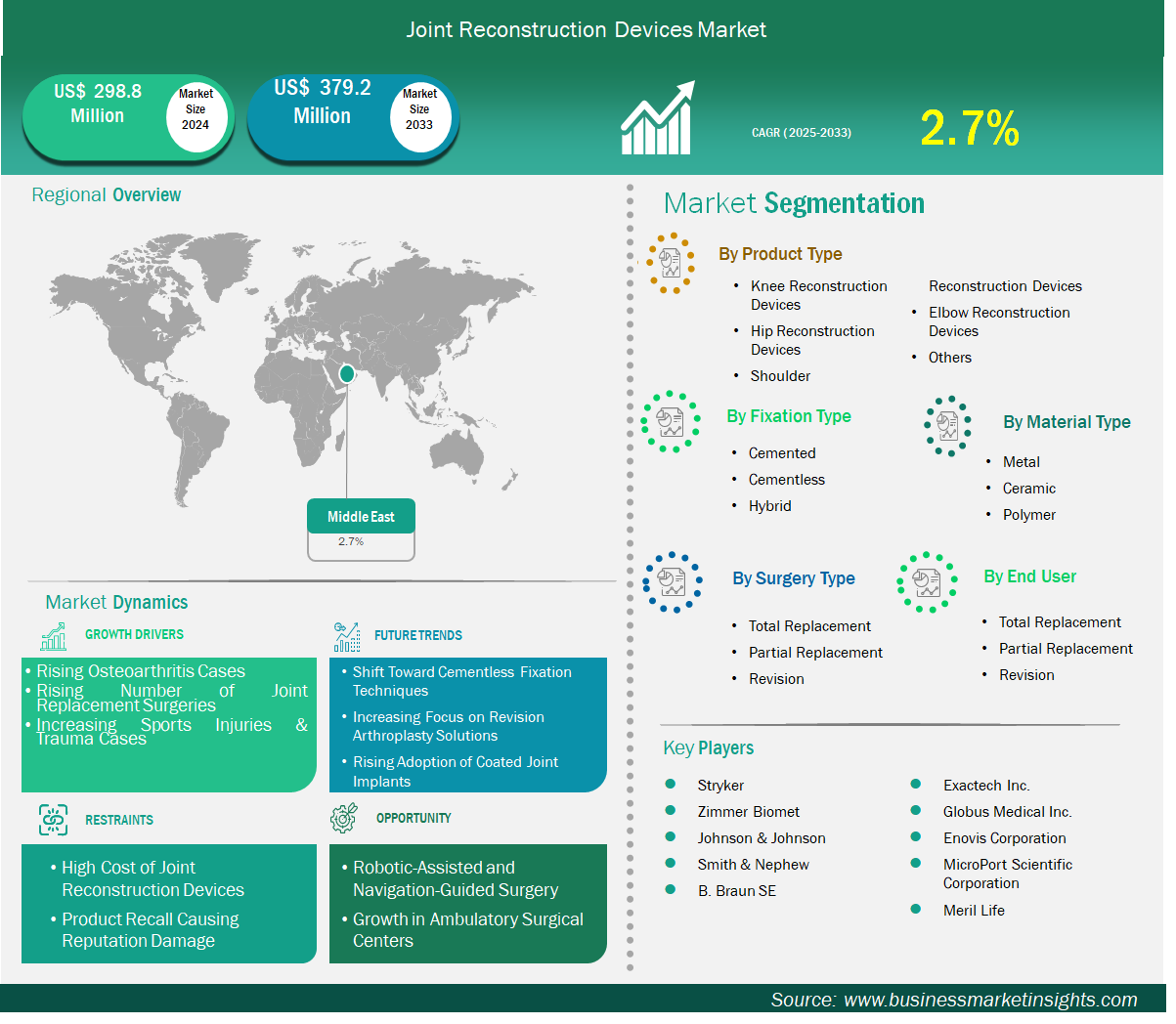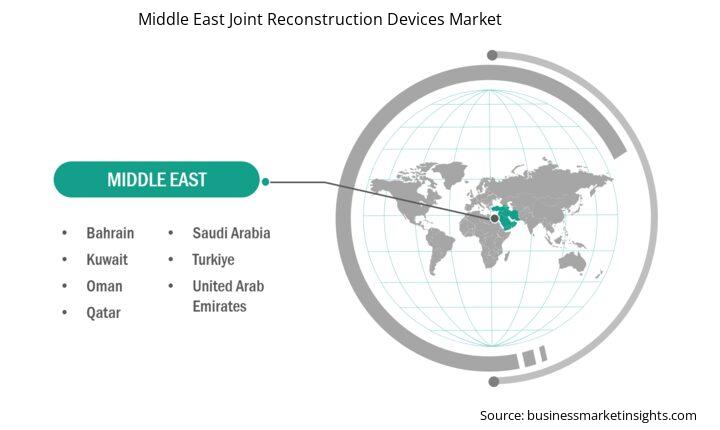Middle East Joint Reconstruction Devices Market Outlook (2022-2033)
No. of Pages: 150 | Report Code: BMIPUB00031859 | Category: Life Sciences
No. of Pages: 150 | Report Code: BMIPUB00031859 | Category: Life Sciences
Middle East joint reconstruction devices market size is expected to reach US$ 379.2 million by 2033 from US$ 298.8 million in 2024. The market is estimated to record a CAGR of 2.7% from 2025 to 2033.
The joint reconstruction devices market in the Middle East is diverse, reflecting varying levels of healthcare development across the region. Countries such as Saudi Arabia, the United Arab Emirates, Qatar, and Kuwait are at the forefront, offering advanced orthopedic services and adopting technologies like robotic-assisted surgery and computer-navigated joint replacement. These markets are supported by strong healthcare investment, structured hospital networks, and partnerships with global device manufacturers.

Key segments that contributed to the derivation of the joint reconstruction devices market analysis are product type, fixation type, material type, surgery type, and end user
The joint reconstruction devices market in the Middle East is expanding, with countries like Saudi Arabia, the UAE, Qatar, and Kuwait leading due to strong healthcare investment, advanced surgical capabilities, and adoption of modern technologies like robotic- assisted surgery. Outside the GCC, nations such as Jordan, Lebanon, and Egypt contribute modestly, with private hospitals driving innovation amid public sector limitations. International device manufacturers support growth through partnerships, training, and clinical programs. Rising awareness of joint disorders and a regional focus on quality of life and mobility are key drivers. Despite varying development levels, the region shows a clear shift toward advanced, patient-centered orthopedic care.
Based on country, the Middle East joint reconstruction devices market is further segmented into the UAE, Saudi Arabia, Bahrain, Oman, Kuwait, Qatar, And Turkey. The Saudi Arabia held the largest share in 2024.
Saudi Arabia's joint reconstruction devices market is evolving rapidly, supported by substantial investment in healthcare modernization and growing demand for hip and knee replacement procedures. Public and private hospitals are expanding orthopedic services, and advancements in surgical technology are driving market progression. In May 2024, a major hospital in Saudi Arabia launched the nation's first robot-assisted knee replacement surgery by conducting a revolutionary medical procedure through cutting-edge orthopedic surgical methods. For the first time in Madinah, the medical staff used a robot system to replace a patient's knee joint in her seventies. This is a strong sign of commitment towards adopting advanced surgical systems and improving patient results. This achievement highlights increased cooperation between hospitals, device companies, and training centers to develop top-level orthopedic capacity.
Middle East Joint Reconstruction Devices Market Report Highlights
Report Attribute
Details
Market size in 2024
US$ 298.8 Million
Market Size by 2033
US$ 379.2 Million
CAGR (2025 - 2033) 2.7%
Historical Data
2022-2023
Forecast period
2025-2033
Segments Covered
By Product Type
By Fixation Type
By Material Type
By Surgery Type
Regions and Countries Covered
Middle East
Market leaders and key company profiles
Middle East Joint Reconstruction Devices Market Company Profiles
Stryker, Zimmer Biomet, Johnson & Johnson, Smith & Nephew, B. Braun SE, Exactech Inc., Globus Medical Inc., Enovis Corporation, MicroPort Scientific Corporation, and Meril Life are among the key players operating in the market. These players adopt strategies such as expansion, product innovation, and mergers and acquisitions to stay competitive in the market and offer innovative products to their consumers.
The following methodology has been followed for the collection and analysis of data presented in this report:
The research process begins with comprehensive secondary research, utilizing both internal and external sources to gather qualitative and quantitative data for each market. Commonly referenced secondary research sources include, but are not limited to:
Note: All financial data included in the Company Profiles section has been standardized to US$. For companies reporting in other currencies, figures have been converted to US$ using the relevant exchange rates for the corresponding year.
Business Market Insights conducts a significant number of primary interviews each year with industry stakeholders and experts to validate and analyze the data and gain valuable insights. These research interviews are designed to:
Primary research is conducted via email interactions and telephone interviews with industry experts across various markets, categories, segments, and sub-segments in different regions. Participants typically include:

The Middle East Joint Reconstruction Devices Market is valued at US$ 298.8 Million in 2024, it is projected to reach US$ 379.2 Million by 2033.
As per our report Middle East Joint Reconstruction Devices Market, the market size is valued at US$ 298.8 Million in 2024, projecting it to reach US$ 379.2 Million by 2033. This translates to a CAGR of approximately 2.7% during the forecast period.
The Middle East Joint Reconstruction Devices Market report typically cover these key segments-
The historic period, base year, and forecast period can vary slightly depending on the specific market research report. However, for the Middle East Joint Reconstruction Devices Market report:
The Middle East Joint Reconstruction Devices Market is populated by several key players, each contributing to its growth and innovation. Some of the major players include:
The Middle East Joint Reconstruction Devices Market report is valuable for diverse stakeholders, including:
Essentially, anyone involved in or considering involvement in the Middle East Joint Reconstruction Devices Market value chain can benefit from the information contained in a comprehensive market report.